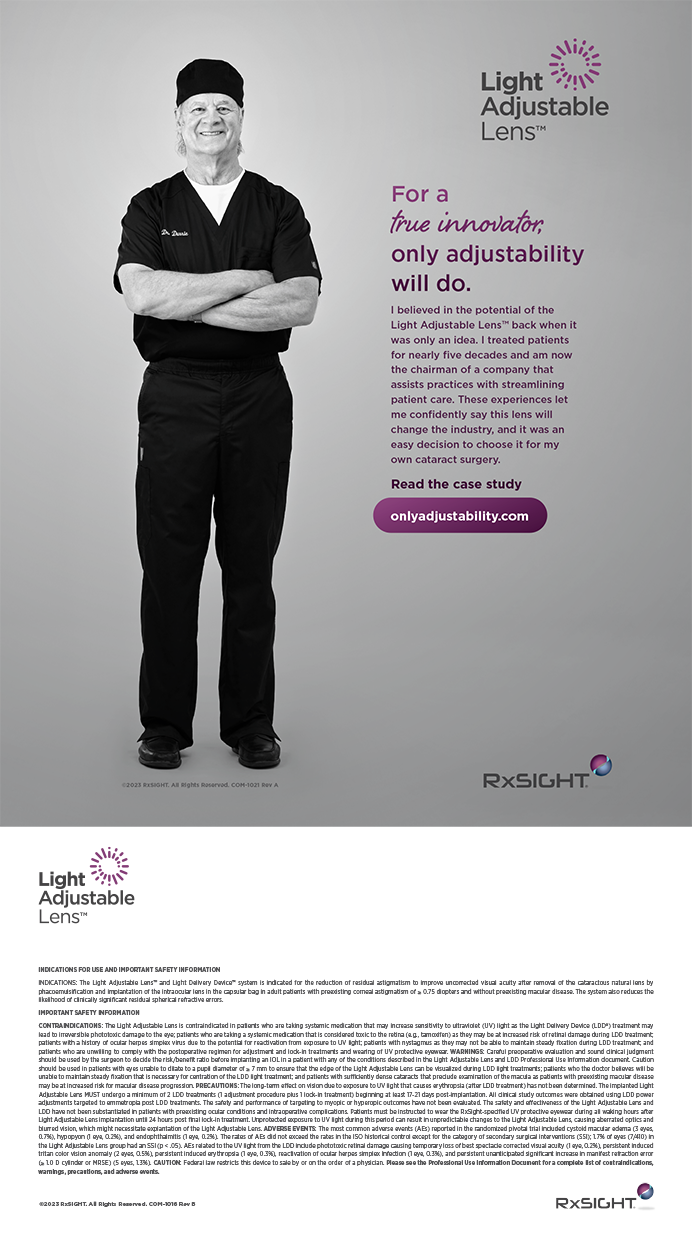The Ultrachoice 1.0 hydrophilic acrylic, posterior-chamber IOL (Thinoptx, Abingdon, VA) was designed with a profile so thin that it can be rolled (Figure 1) and inserted through incisions that are much smaller than those used for other foldable lenses. Some surgeons claim to have inserted the Ultrachoice 1.0 lens through an incision of 1.0 to 1.5mm. After cutting the optic to 5mm in diameter, Amar Agarwal, MS, FRCS, FRCOphth, implanted the lens through a 0.70-mm incision in Chennai, India. The lens features a plate-haptic shape and sits in the capsular bag (Figure 2).
The IOL received CE Marking in 2002 and began FDA clinical trials in July 2004. I was prepared for the FDA study, because John Hunkeler, MD, and I had implanted several Ultrachoice 1.0 lenses at the clinic of Arturo Chayet, MD, in Tijuana, Mexico, on December 27, 2002. Follow-up of the patients revealed no problems. This article shares my results.
REPORT
After careful informed consent, I implanted the Ultrachoice 1.0 lens in three eyes at my ambulatory surgery center, St. Mary's Eye Center, in Santa Monica, California. The results were spectacular in terms of visual acuity and the quality of central vision. All three patients achieved a UCVA of 20/25 or better and a BCVA of 20/20. Two of them saw 20/15 within the first several days postoperatively. Obviously, I was quite pleased.
Unfortunately, at the very beginning of the study, a flaw in the anterior surface of the central optical zone became apparent. The problem of optical aberrations arose in the first postoperative week. Although patient No. 3 never experienced any optical aberrations, patient No. 1 had minor halos at night, whereas patient No. 2 complained of large, multicolored, concentric halo rings in his nighttime vision, especially around lights. He was an engineer and noted several interesting things. First, his central acuity was the "sharpest I have ever had in my life." Second, the rings that he observed were beautiful colors he had never seen before and changed color depending upon the light source.
I immediately reported these phenomena to Thinoptx, which began lot inspections of the lenses it had produced. One week later, I was examining all three eyes under very high slit-lamp power during videography of the implanted lenses. With patient No. 2, I observed a series of microscopic concentric rings (ridges) on the anterior surface of the central optic that started at the center of the IOL and grew gradually less elevated peripherally (Figure 3). When I examined patient No. 1, I noted the same ridges, but they were much less prominent. There were barely any ridges on the IOL of patient No. 3.
I theorized that the ridges were causing the unwanted halos and immediately informed the company. After a thorough investigation of all manufacturing methods and procedures, Thinoptx discovered the problem: a new lathe was producing prominent concentric ridges around the optical center. The company immediately ceased using this lathe, destroyed all lenses produced with it, and instituted a quality-control inspection (specifically for prominent rings) of every lens' anterior surface.
As Medical Monitor, I requested that the FDA trials be suspended directly pending further investigation. I then organized a European multicenter study of lenses produced after the defect's discovery. The investigation began in April 2005, and my colleagues and I have been carefully collecting data on lenses implanted in many European countries by several different surgeons.
When all of the data have been collected, the results will be presented. So far, the results appear to be very positive for the recently manufactured lenses, but the study is not yet complete. Once the data have been analyzed, it would be appropriate for the FDA trials to resume.
THOUGHTS
From a personal perspective, it was no fun encountering these problems with my patients, but I have been most impressed by the quality of vision that they described. Patient No. 1 has been using Alphagan (Allergan, Inc., Irvine, CA). She has noted halos only rarely and would not want the lens removed because of the high quality of her vision as compared with her other eye, which has a standard, monofocal, biconvex, posterior-chamber IOL.
Patient No. 2 begged me to replace his faulty IOL with a new Ultrachoice 1.0 lens and was disappointed to learn that the FDA would not permit it. He waited 4 months to see if the situation would change before allowing me to exchange the Ultrachoice 1.0 lens for my standard plate-haptic lens (STAAR Surgical Company, Monrovia, CA). Postoperatively, his vision was 20/15, but he said the clarity was less intense than with the Ultrachoice 1.0 lens. When it was time for cataract surgery on his second eye, he requested the Ultrachoice 1.0 lens but was again disappointed.
I am hopeful that the FDA trials can begin in the near future so that the IOL will be available to US surgeons.
Kenneth J. Hoffer, MD, is Clinical Professor of Ophthalmology at UCLA. He is the Chairman of the Board of Thinoptx. Dr. Hoffer may be reached at (310) 451-2020; khoffermd@aol.com.


